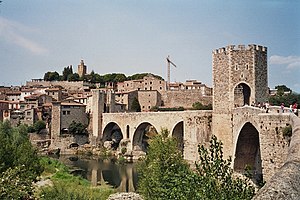County of Besalú
The County of Besalú (
County of Besalú | |||||||||
|---|---|---|---|---|---|---|---|---|---|
| 878–1111 | |||||||||
| Capital | Feudal County | ||||||||
| Count of Besalú | |||||||||
• 878-912 | Radulf (first) | ||||||||
• 1100-1111 | Bernard III (last) | ||||||||
| Historical era | Early Middle Ages | ||||||||
• Established | 878 | ||||||||
• Disestablished | 1111 | ||||||||
| |||||||||
| Today part of | |||||||||

9th century: origins and development
Besalú was
In the Ordinatio Imperii of 817,
During the reign of
10th century: attached to Cerdanya
Sometime between 913 and 920, Radulf died and
The brothers, and their younger brothers
In the latter half of the tenth century, the power and authority of the counts of Besalú and Cerdanya increased. In 957, Besalú was rocked by the rebellion of a faction of the noblesse backing the sons of the deceased count Radulf. Wilfred was assassinated and Sunifred annexed the property of the rebels and took over the county. In 965, Sunifred passed all his counties on to Oliba, who gave Besalú as a subordinate countship to Miro, but when Miro became
11th century: independent county

In 988, Oliba entered
The last quarter of the 10th century and first quarter of the 11th witnessed very little war in southern France and Catalonia, some of the only instances occurring between Oliba Cabreta and the
In 1066,
At the turn of the 12th century, Besalú extended as across the
In 1107, Bernard III married Jimena, Raymond Berengar's daughter. In the marriage pact, Raymond Berengar ceded
In 1111, Bernard died and Barcelona inherited Besalú. This led to conflict with Bernard William of Cerdanya, who was the feudal suzerain of Besalú. The problem was solved by the cession of Vallespir, Fenolledès, Peyrepertuse, and Castellnou to Cerdanya for compensation.
Bishopric of Besalú
Some of the most important monasteries in Catalonia were located in Besalú:
On Bernard's death in 1020, the bishops of Girona and Vic reclaimed their ancient rights over the parishes of Besalú. Wilfred, lacking a political protector, retired to his monastery and the diocese of Besalú was abolished.
List of counts
- Radulf, 878–912
- Miro I the Younger, 912–927
- Ava, 927–941, as regent for...
- Wilfred (II), 927–957
- Sunifred, 957–965
- Miro II Bonfill, 965–984
- Oliba Cabreta, 984–988
- Bernard I, 988–1020
- William I, 1020–1052
- William II, 1052–1066
- Bernard II, 1066–1100
- Bernard III, 1100–1111
See also
- Viscounty of Besalú
Sources
- Lewis, Archibald Ross. The Development of Southern French and Catalan Society, 718–1050. University of Texas Press: Austin, 1965.
- Cheyette, Fredric L. Ermengard of Narbonne and the World of the Troubadours. Ithaca: Cornell University Press, 2001.
- ISBN 84-232-0520-7.
